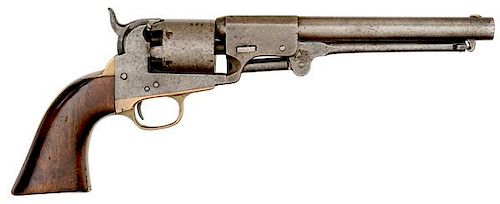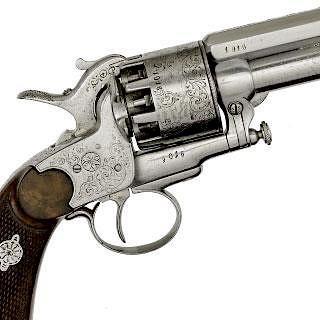J. H. Dance & Brothers Navy Percussion Confederate Revolver Without Recoil Shield
About Seller
6270 Este Ave.
Cincinnati , OH 45232
United States
With offices in Cincinnati, Cleveland and Denver, Cowan’s holds over 40 auctions each year, with annual sales exceeding $16M. We reach buyers around the globe, and take pride in our reputation for integrity, customer service and great results. A full-service house, Cowan’s Auctions specializes in Am...Read more
Two ways to bid:
- Leave a max absentee bid and the platform will bid on your behalf up to your maximum bid during the live auction.
- Bid live during the auction and your bids will be submitted real-time to the auctioneer.
Bid Increments
| Price | Bid Increment |
|---|---|
| $0 | $25 |
| $500 | $50 |
| $1,000 | $100 |
| $2,000 | $250 |
| $5,000 | $500 |
| $10,000 | $1,000 |
| $20,000 | $2,500 |
| $50,000 | $5,000 |
| $100,000 | $10,000 |
About Auction
Apr 26, 2016 - Apr 28, 2016
Cowan's Auctions dawnie@cowans.com
- Lot Description
.36 caliber, 7.375" octagonal-to-round barrel, S/N 135. Numbered on the barrel, cylinder, backstrap, trigger guard, cylinder pin and hammer. Three cylinder pins on the back of the cylinder remain; the rest are battered down from use. Made without recoil shield. Brass backstrap and trigger guard. One-piece walnut grip.
Always considered a "holy grail" for the advanced Confederate arms collector, the Texas J.H. Dance & Brothers revolver was produced in both .44 caliber, and rarely, .36 caliber. Total production for the Dance was approximately 325 to 500, and most scholars believe that 275-350 were in the larger caliber size.
Few honest .36 caliber Dance revolvers exist today. Early Dance Navy's are known with a recoil shield, but they are few in number and all that have survived have serial numbers below 100. Likewise, of those Dance Navy's without a recoil shield, very few are known today. There is no serial number overlap for the guns with or without a recoil shield.
This revolver has been known to collectors since 1954, when Cincinnati collector and founding member of The American Society of Arms Collectors Herman Strumpf sold it to Cliff Young for the unheard of sum of $1000. At the time -- serial number 135 -- was one of two known examples of the Dance Navy in .36 caliber and without recoil shield. The only other example, serial number 119, remains part of the Nunnemacher Collection of Firearms, curated by the Milwaukee Public Museum. Since then, a few additional examples have surfaced, though less than ten are known to exist.
Literature:
Albaugh, William.
1963 Confederate Handguns. Riling
This gun is illustrated on the back cover, as well as on page 159.
Gary, Bill.
1987 Confederate Revolvers. Taylor Publishing, page. 66.
Wiggins, Gary.
1986 Dance & Brothers Texas Gunmakers of the Confederacy. Moss Publications, pages 72-73.
All metal has an untouched patina with a dark even look. Some pitting blending in as well as some black staining. All lines are sharp and crisp. Brass backstrap and trigger guard with untouched patina and even look. Barrel still retains the rifling with some pitting and rough bore. Grips are good with dark patina. Two old hairline cracks have been repaired on both sides of the grips at the frame.Condition
- Shipping Info
-
SHIPPING. At the request of the buyer, Cowan's will authorize the shipment of purchased items. Shipments usually occur within two weeks after payment has been received. Shipment is generally made via UPS Ground service. Unless buyer gives special instructions, the shipping method shall be at the sole discretion of Cowan's Auctions, Inc.. Cowan's is in no way responsible for the acts or omissions of independent handlers, packers or shippers of purchased items or for any loss, damage or delay from the packing or shipping of any property.
-
- Buyer's Premium



 EUR
EUR CAD
CAD AUD
AUD GBP
GBP MXN
MXN HKD
HKD CNY
CNY MYR
MYR SEK
SEK SGD
SGD CHF
CHF THB
THB


















